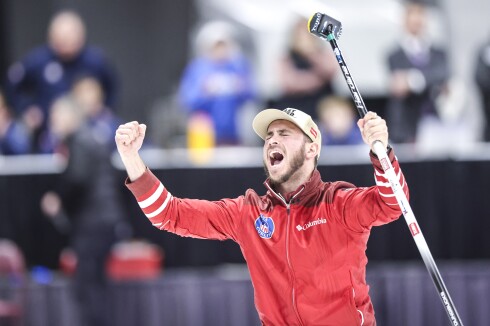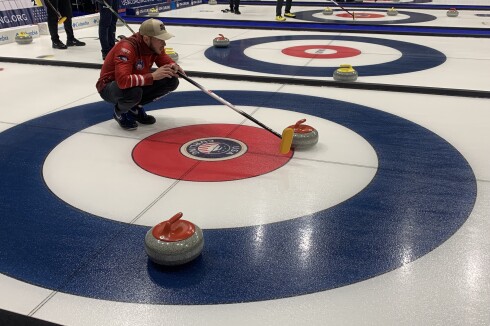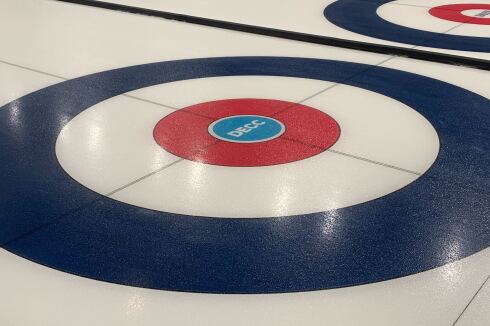Minnesota Duluth's Scott Sandelin isn't just a coach. He's a hockey dad as well. He has a son and a daughter who play the sport.
Ryan, 19, is entering his second year of junior hockey. He's already been through the recruitment process, committing to Minnesota State-Mankato prior to his senior season at Hermantown.
ADVERTISEMENT
Katie, 12, is a youth player in the Hermantown hockey program, this year playing on the girls U-12A squad. She should be 4-5 years away from thinking about college. The only verbal commitments that should be on her mind are the ones her dad is chasing down for the Bulldogs.
Unfortunately, that's not the way the hockey world works these days.
"I'm looking at kids, my daughter is an '06 birth year, and we have kids that are '04s, two years older, committing to college," Scott Sandelin said. "It's scary."
If a recent NCAA proposal is passed next spring, Katie Sandelin and every other male and female hockey player their age should be able to put off a major step toward adulthood a little longer.
Last month the NCAA Division I council introduced two recruiting proposals into the legislative process in hopes of slowing down recruiting not only in hockey, but all sports. Should the proposals pass in April, the days of verbal commitments by high school sophomores, freshmen and even eighth-graders will be a thing of the past.
The creators behind these proposals also believe the changes will reduce the number of decommitments and maybe even bring some civility back to a recruiting environment that has become hostile in recent years as the validity of verbal commitments is questioned.
"I think it's crazy," Scott Sandelin said of recruiting 13- and 14-year olds, which he did with Joey and Mikey Anderson. Both committed prior to high school. "I think it's crazy, but I can have my opinion. Other coaches are going to have theirs."
ADVERTISEMENT
What's new?
Men's and women's hockey will have separate schedules, but both proposals aim to accomplish the same goal of slowing down the recruiting process.
Under the new proposal for the men, all contact and communication between a coach and student-athlete is banned until Jan. 1 of the student-athlete's sophomore year of high school. After that, coaches and athletes may communicate via telephone calls, text messages and other similar communications. They can meet face-to-face on campus during a camp, clinic or unofficial visit (paid for by the student), but not off campus.
What a coach can't do under the proposal is make any sort of scholarship offer. That isn't permitted until Aug. 1 prior to a student-athlete's junior year of high school. Also permissible starting Aug. 1 prior to junior year is off-campus contact and official visits (paid for by the school) to campus.
For the women and all other sports other than basketball, football and men's hockey, all communication is banned until June 15 after the sophomore year. Visits - official or unofficial - can't take place until Aug. 1.
UMD's Maura Crowell said as a coach in the West, she'd like to see women's hockey play by the same recruiting rules as the men.
"January of sophomore year could be interesting timeline because our location is a little different than others," Crowell said. "So for schools that aren't right in the hub, it gives kids time to plan and come here, to make sure we're on the list. We want to be on the top players lists. When it is financially difficult for them to come here, that becomes a problem."
ADVERTISEMENT
Because of the different challenges men's hockey faces - the influence of professional agents and major junior hockey leagues - the sport became proactive about making sure it wasn't grouped in with every other sport like the women. They formed a committee that included a commissioner, coach and administrator from all six conferences. The NCHC was represented by commissioner Josh Fenton, Scott Sandelin and Ken Ralph, the former Colorado College athletic director who is now AD at Maine.
The committee worked for two-plus years on the proposal, starting in 2016.
"We're proposing this because we believe it's right and fair and good for the prospects and the prospects' families and it's going to make the recruiting environment better," Fenton said.
The impact
Fenton emphasized a couple points about the new proposal that should change current recruiting practices.
The first is eliminating all recruiting conversations prior to Jan. 1 of a student-athlete's sophomore year. Coaches cannot currently contact recruits until Jan. 1, but a recruit can contact a coach by calling them (the coach has to pick up, he or she can't return a message) or visiting them on campus in person.
So for example, if a 12-year-old calls a coach and he or she picks up, they can have a recruiting conversation. And that recruiting conversation can lead to a scholarship offer and acceptance of that offer.
ADVERTISEMENT
That loophole has been closed, leading to Fenton's second key point. No verbal offers of athletic aid can be made prior to Aug. 1.
That means the tweets and Instagram posts offering "thanks to everyone who helped along the way" should only be coming from high school juniors, seniors or graduates.
And if one pops up on the account of a freshman or sophomore or younger, it should prompt an investigation into an NCAA rules violation, Fenton said.
"If you're going to openly know the rules, openly break the rules by accepting a call from a prospect prior to Jan. 1 of Grade 10 or providing a verbal offer to a prospect before Aug. 1 of grade 11, then you are going to subject yourself to potential NCAA infractions processing," Fenton said.
In addition to slowing down the recruiting process, Fenton said this proposal also shrinks the window in which a recruit is verbally committed. Verbal commitments are non-binding and some people - players and coaches - take them more seriously than others.
In the eyes of the NCAA, only a signed national letter of intent - which can first be signed in November of a student-athlete's senior year - is binding. Shortening that window between when an unofficial verbal commitment is made and when the ink hits the paper of a letter of intent from 4-6 months to 1-3 months should lead to significantly fewer decommitments, Fenton said.
That smaller window also could lead to a healthier recruiting environment, the commissioner added. Coaches are more likely to respect a verbal commitment made by a player when he or she is 16 or 17, rather than one that came before they received their learner's permit to drive.
ADVERTISEMENT
The same goes for a player who is much more mature and prepared to be thinking about college 1-2 years out rather than 3-4.
"I think it will help. I think you'll see fewer decommitments down the road because now kids are making earlier decisions just to make them," said Scott Sandelin, who had his own recruiting rules in place for when his son, Ryan, was going through the process.
Though there was one exception to dad's rules.
"The message I gave to my son is you make sure you take your time," Scott Sandelin said. "At the end of the day for him, for me, I told him, 'Whatever decision you make you're not decommitting. So you better like it.'
"Unless it was probably playing for me, then he would have decommitted right away."









